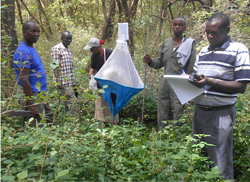
Residents of Marigat were for a long time trapped in a cycle of poverty. At the centre of it were tsetse flies tat rendered the green pastures useless and livestock keeping almost futile.
Tsetse flies had literally killed the main economic activity, livestock keeping. The story changed tune when the government rolled out a project to eradicate the flies. Out of desperation, the residents as if cursing their green abundant pastures had christened them “nyalilbuch,” which loosely translates into “good-for-nothing-pastures.”
“Yes the area had lush pastures, but heavily infested with tsetse flies. The livestock could run away from the appetizing green grass. Out of frustration we called them nyalilbuch, says Gladys Chepkemoi, now a happy farmer in Kapkuikui location of Marigat sub County.
“He will tell you, we used to trap 2kgs of tsetse flies when Pan-African Tsetse and Trypanosomiasis Eradication Campaign (PATTEC) started its operations here.” Gladys adds , in the company of the Kenya Tsetse and Trypanosomiasis Eradication Council (KENTTEC) regional coordinator Mr. Ronald Ochwada. Ms. Chepkemoi represents many other farmers in the area that have now embarked on dairy farming. Exotic dairy animals now dot the landscape of Marigat Sub County with the pastures having been cleared off tsetse flies. KENTTEC has been working with the local community to eradicate tsetse flies and nagana. The Council supports farmers to spray their animals, sets insecticide impregnated nets in the field and fences zero grazing units with insecticide treated nets.
This is what has drastically reduced the tsetse fly populations. Majimoto Secondary School is another beneficiary of tsetse eradication in Emsos location, Marigat Sub County. The Council supported the school to acquire a dairy cow that has calved four times and is currently supplying milk to the school where the agriculture students learn dairy farming techniques.
The large tracts of land under crop cultivation in Marigat are proof that tsetse flies are virtually eradicated in the area. Bulls are the main sources of draught power for the farmers. With tsetse flies eradicated and nagana gone, the bulls are now healthy and are used to plough large pieces of land which has greatly improved crop production in Emsos location.
The Council is now promoting commercial dairy farming in the area through provision of sexed semen to be used in the artificial insemination of dairy animals. The goal is to speed up genetic improvement of livestock to boosted milk and meat output and generate more income for the farmers.
KENTTEC has been working with the local community to eradicate tsetse flies and nagana. The Council supports farmers to spray their animals, set insecticide impregnated nets in the field and fence zero grazing units with insecticide treated nets
Tsetse flies are sometimes referred to as “poverty insects” – a nickname attributed to their impoverishing effects. The flies are the main transmitters of a disease that affects both man (sleeping sickness) and animals (nagana). Both are fatal diseases if not treated on time and appropriately. Nagana causes abortions, wasting of body and reduced milk yield. Sleeping sickness is a horrible human disease characterized by disturbed sleep patterns, mental disorders and is difficult and painful to treat. The good news is that through government support, sleeping sickness was last reported in 2009. With enhanced partnerships and resources, the government is close to eradicating the disease. KENTTEC was established through a Gazette Notice No 77 of July 2012. It is the successor to the Pan African Tsetse and Trypanosomiasis Eradication Campaign (PATTEC) coordinated by the African Union (AU) following the Lome Togo Declaration by the African Heads of States and Governments in July, 2000 (Decision: AHG/156 XXXVI) to free the continent from the constraints of Tsetse and Trypanosomiasis.
The eradication of tsetse flies and nagana is in line with the Big Four Agenda pillars on Food and Nutrition security and Manufacturing. Through its work, KENTTEC has contributed to the progressive achievement of the Agricultural Sector Transformation and Growth Strategy (2019-2029).
But the success of the tsetse and Trypanosomiasis campaigns is not limited to Marigat Sub- County. The Council has trained farmers on animal husbandry and supported dairy farming models for tsetse fly infested areas in the country.
As a result, commercial farms have come up in areas previously infested with the flies like Thiba Farm in Mwea which has over 100 dairy cattle and goats and employs over 200 youth and women from the area.
The Council has also trained youths on Artificial Insemination (AI) and provided them with AI. Kits. The youths are supporting communities to upgrade their livestock.
2009 – Last reported case of sleeping sickness, through government support. Sleeping sickness is a horrible human disease characterized by disturbed sleep patterns, mental disorders and is difficult and painful to treat
Farmers have been sensitized on the use of embryo transfer technology and sexed semen as a means of improving production. This will increase milk and meat production, create employment, invest in other economic activities and create wealth.
